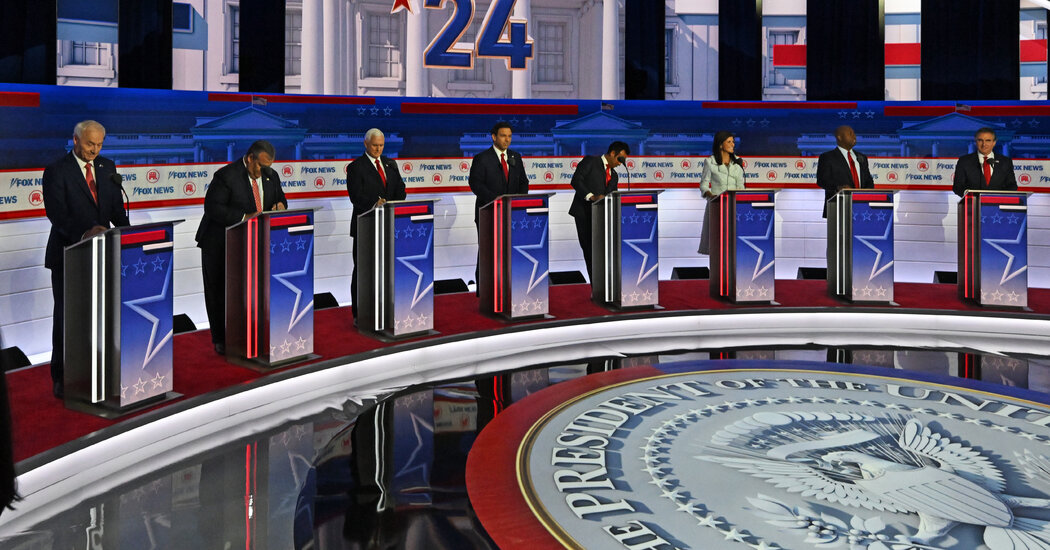It was the battle of power ties.Red is the Republican Party color. Red was the tone of offense mounted by presidential candidates who came out swingin
It was the battle of power ties.
Red is the Republican Party color. Red was the tone of offense mounted by presidential candidates who came out swinging. And red, of course, is the 800-pound political gorilla who skipped the debate: Donald J. Trump. With the exception of the former South Carolina governor Nikki Haley, every Republican in Milwaukee for the first debate of the 2024 presidential campaign wore a red necktie. Most were solid slashes against a crisp white (or in Tim Scott’s case, white-ish blue) shirt and offset by the frame of a dark blue suit. It was as though Betsy Ross had styled the debate.
For at least some segment of the viewing public, however, the most pressing issue of the day may not have concerned Bidenomics, abortion rights, deregulation or the candidates’ general positions and values. It was not even who might wrest voter attention back from the canniest scene-stealer in American political life. It was whether Ron DeSantis — the governor of Florida and, pre-debate, the stiffest competition Donald J. Trump faces for the Republican nomination — wears lifts.
Height and hair are often cited as key determinants in how voters view candidates. That’s the folklore, and history suggests it contains a germ of truth. Think of John F. Kennedy’s forelock. Think of George W. Bush’s Texas barbershop special. Think of Bill Clinton’s Arkansas pompadour or even Mr. Trump’s preternaturally blond hairdo, a tonsorial confection defying equally comprehension and the laws of physics.
As for Governor DeSantis, his hair looks thick enough to comb with a rake. It is a matinee idol mane, styled perhaps in a manner more “West Side Story” than West Wing, yet projecting potency and vigor, as Samson’s did. In the battle of optics he has that undeniable asset. So, too, do Vivek Ramaswamy, Doug Burgum (salt-and-pepper version) and Mike Pence. Questions about Mr. DeSantis’s height, on the other hand, arose again online as they have since he first threw his hat in the ring.
How did he suddenly level up onstage? What were the debaters standing atop? Absent a camera pullback, the debate stage contenders all appeared to be the same height. When Piers Morgan interviewed Mr. DeSantis, the internet lit up about the stature of the governor, who seemed dwarfed by the British television host in their photo op.
Out on the trail the issue is manageable, as candidates stand on daises or boxes at state fairs or, when they are out pressing the flesh, can be maneuvered out of harm’s way by their handlers. This is hard to do when everyone is arrayed onstage, where it was impossible to know how Vivek Ramaswamy, who has about an inch on Nikki Haley in flats, stood apparently as tall as Chris Christie, a modern colossus at 6 feet 2 inches.
In his long-shot bid for president, Doug Burgum, the governor of North Dakota, has tended to augment his stature (he is 5 feet 9 inches — the median for American males) by wearing cowboy boots with raked elevated heels. Cowpoke gear reads as populist and distracts potential voters from the uncomfortable reality that Mr. Burgum is, in fact, a tech billionaire.
Why does any of this matter? It doesn’t. Or it shouldn’t, considering that no clear science exists to back up the notion that Americans choose their politicians based on height. And yet it is an established fact that a man shorter than the current average height has not been elected president since William McKinley won the 1896 election and that the average U.S. president has been roughly two inches taller than the average American man. Jimmy Carter, at 5 feet 9 and a half inches was the exception. Jimmy Carter has been the exception in everything.
Yet in an image-based world, most understand how crucial optics are to political success. The reality is that, for many beyond the chattering classes, the takeaway from Wednesday night’s debate may in the end not have much to do with the rhetoric. The group photo after the debate will tell the tale.
“Where we are in the culture right now, it’s the nonverbal communication tools that matter most,” said Lauren Rothman, a political image consultant based in Washington, D.C. “We probably don’t have the sound on. The debate is in the background and we’re seeing you on mute. We may ultimately vote for you based on how you come across in a photograph.”
www.nytimes.com

COMMENTS